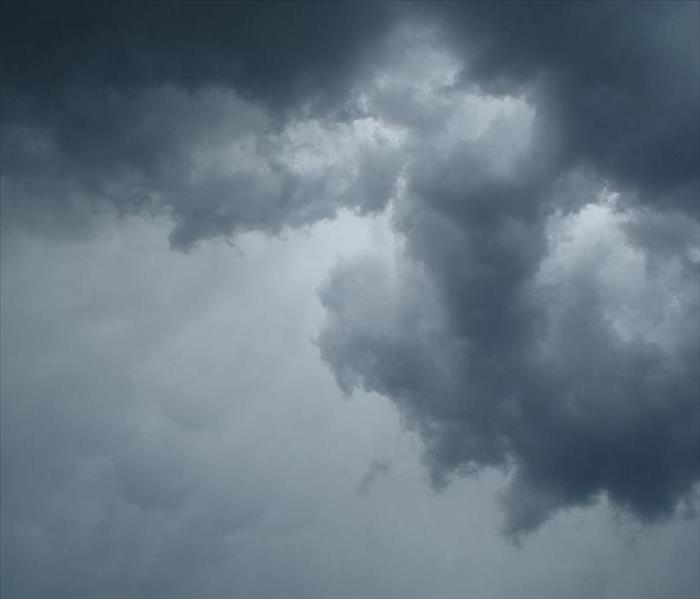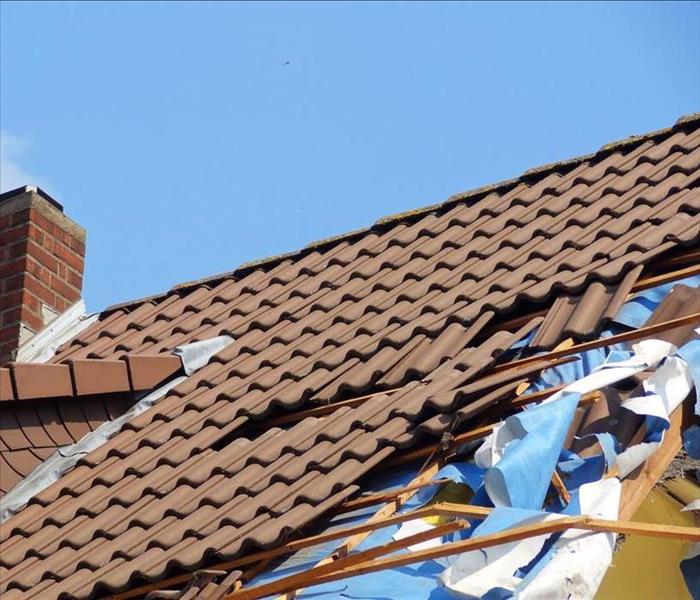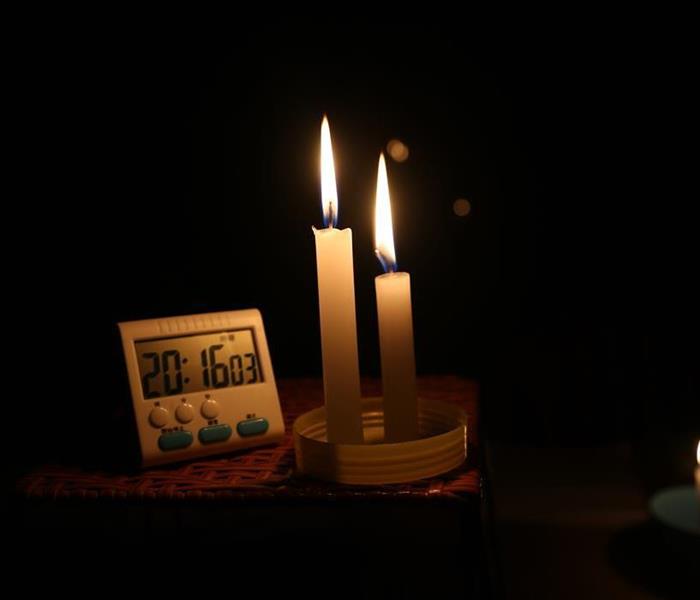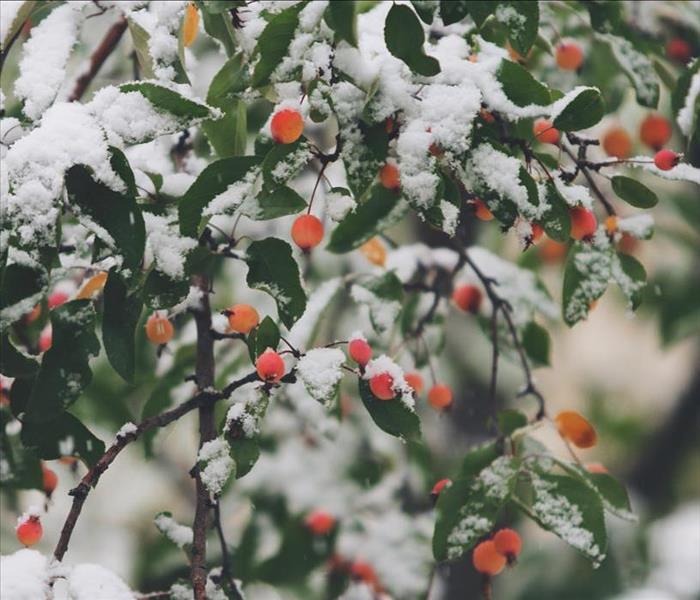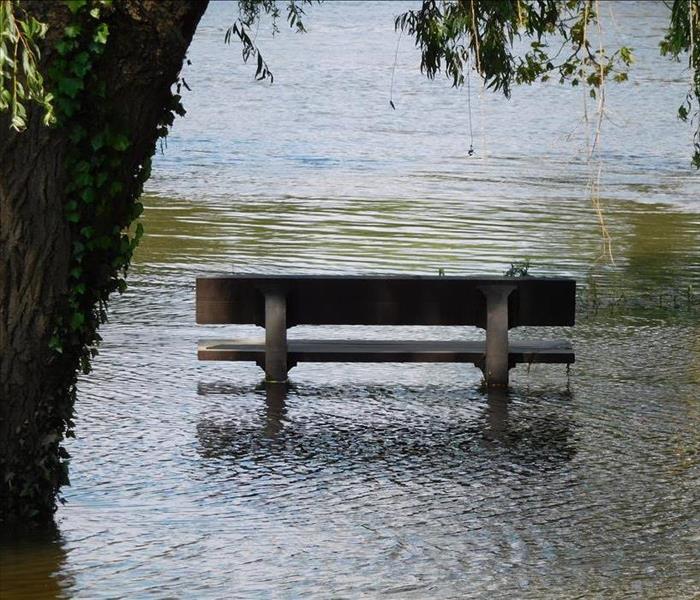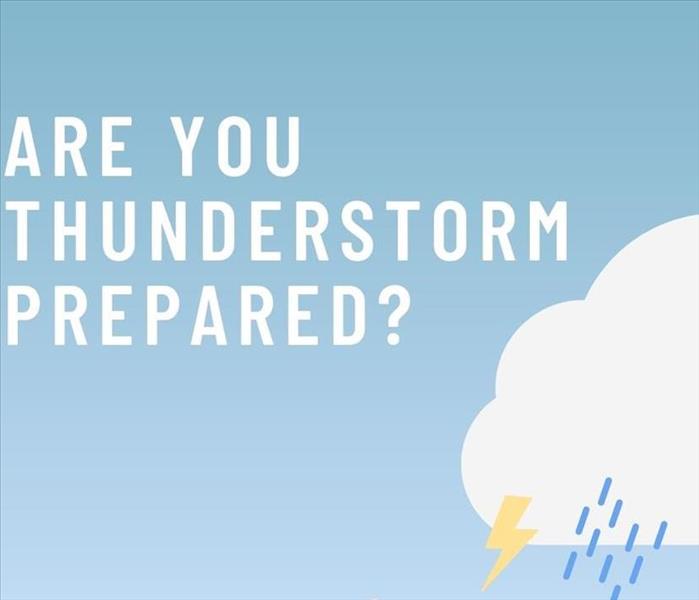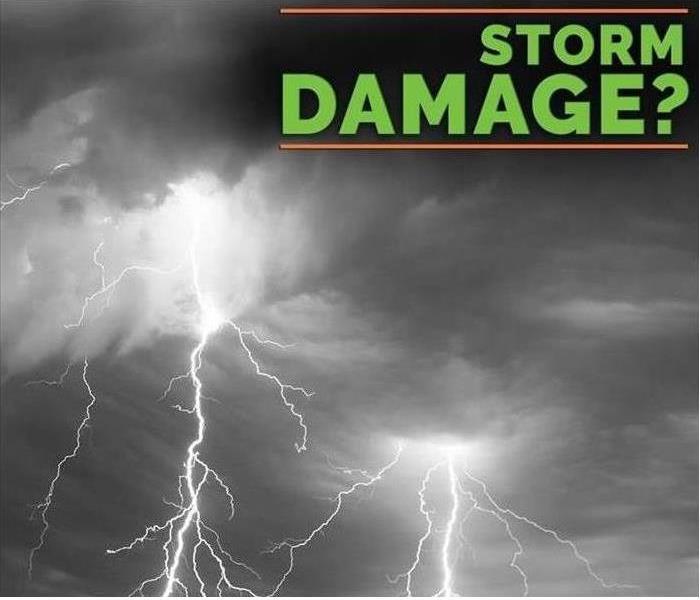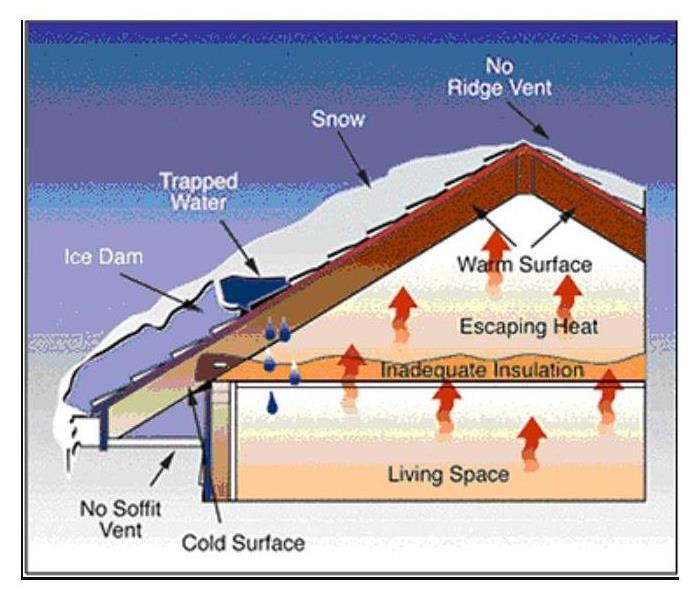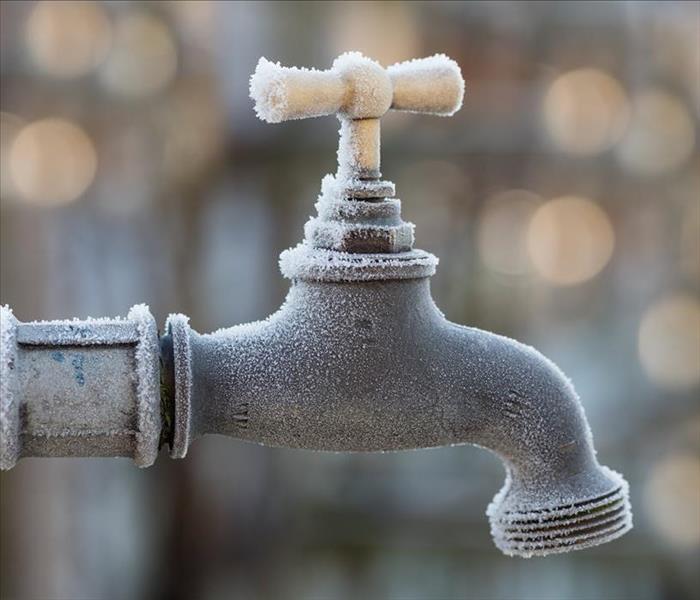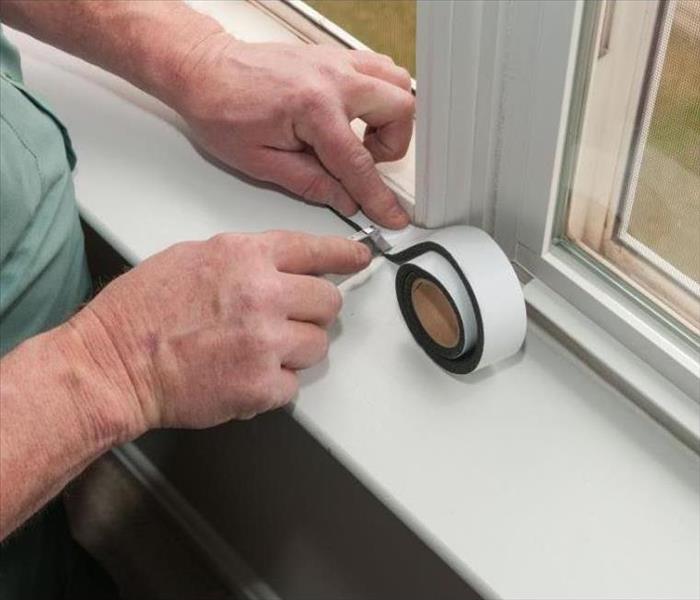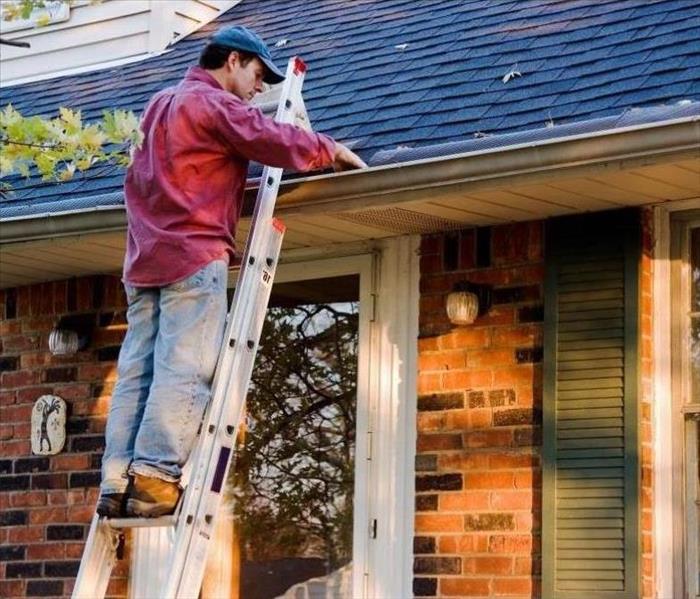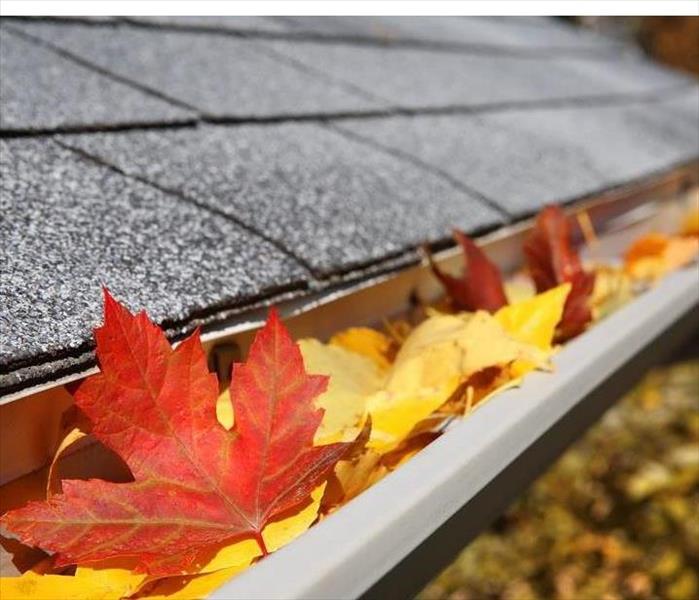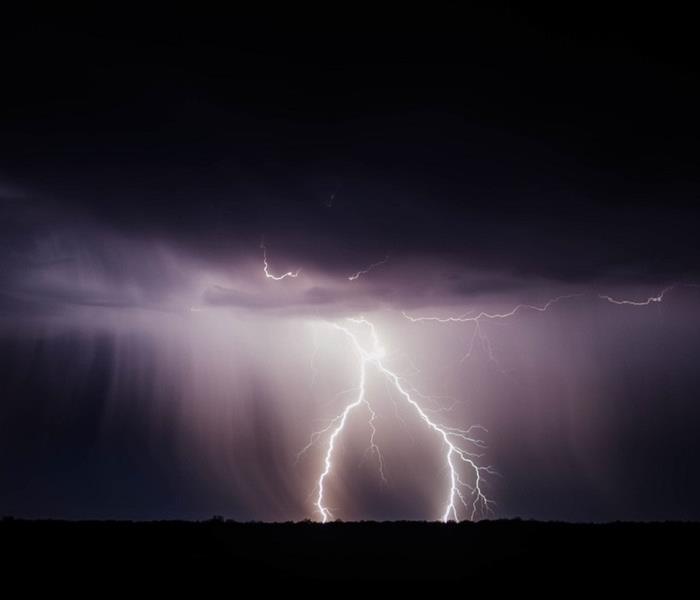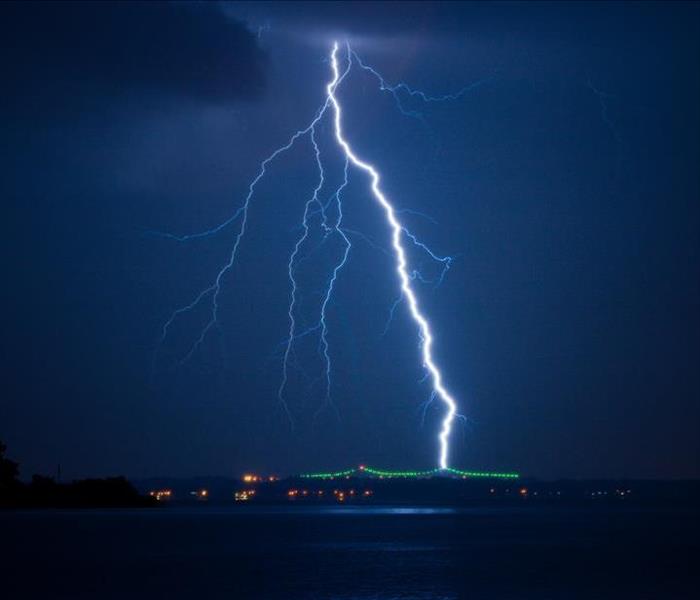Recent Storm Damage Posts
Storm Readiness 101
1/16/2024 (Permalink)
As leaders in the restoration industry, we know firsthand the amount of damage that a storm can do to your home. Addressing the damage as quickly as possible is key to preventing further damage from occurring. We wanted to share some of the most important areas of your home that can be affected by storm damage, so you know where to check afterward.
- Basement – Areas of your home that are underground are some of the spots that are the most prone to water damage following a storm. Check around the edges of your basement floor and walls for signs of moisture. Make sure that drain spouts are properly angled away from your home and that there are no areas where water can pool next to your house.
- Foundation – Similarly to basements, your home’s foundation is particularly threatened by water damage after storms. Water from the outside can seep into cracks in your foundation and weaken it over time. Double-check check there is no standing water or signs of moisture in your concrete, and make sure that your sump pump is functioning properly.
- Crawlspaces – Water can pool in areas underneath your home and cause significant damage to the structural components, like mold and rotting wood.
- Windows – Over time the seals on your windows can degrade and strong storms can crack windows and window frames, allowing water to get into your home.
- Roof – Probably the most prone to storm damage, wind can damage shingles and throw broken tree branches all over your home. As one of the main sources of protection from the outside elements. It is crucial to inspect your roof after a storm. Ensure there are no leaks and remove any debris that could further damage your home. Check for any signs of moisture in your attic as well as this could be a sign that there is a hole somewhere you might’ve missed.
- Gutters – Strong winds and falling branches can damage your gutters or even completely rip them off the side of your house. Your gutters are essential in preventing water from getting into your home and directing it away from your home’s foundation. Make sure that your gutters are in good condition and free from any debris that may clog them.
While storm damage may not always be 100% preventable, hopefully, these tips can help you prevent any further damage from happening, and if you do happen to find any signs of damage to your home after a storm. Our technicians are here to help. We’re available 24/7, 365 days a year, so don’t wait, give us a call and let us know what we can do for you.
Repairing Damage after A Storm
8/11/2022 (Permalink)
SERVPRO of Chesapeake North offers full storm damage cleanup and restoration services for our local area. From a small puddle from a leaky window to a tree falling on your roof and causing severe water damage, our team can help you get your home back to “Like it never even happened.”
Recently our team helped to restore a home after a tree had fallen onto the roof after a storm. The tree broke a hole in the roof in the middle of a rainstorm and the water damage to the home was extensive and spanned multiple floors. Once the tree was removed, we were able to tarp up the roof to prevent any further water intrusions so that we could begin cleanup. First, we addressed the contents of the house, helping to determine what was and wasn’t salvageable and packing it all out to begin water extraction. Once the contents were removed, we were able to set up a plan to get the house dried as efficiently as possible. Our mitigation team visited the home frequently to check on the drying process and ensure that everything was going as planned, taking moisture and humidity readings throughout the process. Our SERVPRO team also offers reconstruction and repair services, so after the water was removed, we worked with the homeowners to help rebuild the home back to preloss conditions. We also boast healthy relationships with many of our local insurance companies and were able to work directly with their agent to help make things as go as smoothly as possible for the homeowners in an already stressful and frantic time.
If your home suffers from storm damage and you are in need of a professional restoration company, look no further than SERVPRO of Chesapeake North. Our teams are available 24/7, 365 days a year for any emergency services. Just give us a call and let us know what we can do for you, we’re always here to help!
What To Do for a Power Outage
2/7/2022 (Permalink)
When big storms roll though your Chesapeake area, especially winter storms, depending on where you live, power outages can be pretty common. Besides the obvious issues of heat/ac, lighting and potential evacuation, power outages come with a host of minor inconveniences as well. A common one is trying to figure out how long your freezer/fridge has been without electricity and whether or not your food is safe to eat still or if it has gone bad from lack of refrigeration. Here’s a quick and easy tip for making trying to figure it out a little easier.
Fill a small glass with water and let it freeze in your freezer. Once the water is frozen, take a quarter and put it on top of the ice in the cup. Now, simply leave that cup inside the freezer. The next time you experience a power outage in your home, or you’ve had to evacuate, you’ll be able to use this cup to help decide on if your food has thawed and is unsafe to eat.
After the electricity has come back on and you’ve returned home, you can check this cup and see where the quarter is. If the quarter is still on top of the cup of water, then it’s likely that your freezer either stayed on, or was not without power for very long, and nothing has thawed out and is still safe to eat. If the quarter is farther down in the cup but not near the bottom, then things might’ve started to defrost but did not completely thaw out. As long as caution is used these items are likely still safe to eat. Finally, if the quarter is on the bottom of the cup, this is an indication that your freezer was likely off for a decent period of time and that the food items have at one point completely thawed out and are probably no longer safe to eat.
It's important to use your best judgment when it comes to making sure food is still safe to eat. If you feel something might not be good any longer then the best plan is to just throw it out, but if you are pretty sure that it is still okay this little frozen quarter trick might help set your mind at ease a little, knowing that the water in the cup never thawed out.
Risks of Winter Storm Damage
1/10/2022 (Permalink)
Storms of any kind can cause all sorts of damage to our homes and businesses. Winter storms however can be some of the worst. These storms carry the same high wind and water damage risks as other storms, with the addition of heavy snow and ice that can cover trees, powerlines, and roads making things slippery and even more dangerous. We wanted to highlight a few potential storm damages that you should watch out for this winter.
Fallen Trees and Branches:
When the temperatures plummet below freezing, ice and snow can accumulate on tree branches. Water is very heavy, and this added weight can cause branches or even entire trees to fall over. Besides the obvious dangers of things falling from above, these branches and trees can take out power lines causing a loss of electricity during a time where heating your home is crucial, as well as falling on your home and damaging your roof and other parts of your house.
Frozen Pipes:
Colder temperatures outside mean that the places in your home that are not directly heated (the parts of your house that your pipes are in) can reach sub-freezing temperatures. During these periods it is especially important to take care of and inspect your water pipes as the potential for pipes to crack is much higher. When water freezes it expands as it turns into ice, if the water in your pipes does this it can cause them to crack under the added pressure of expansion and flood your home.
Roof collapse:
Roofs are meant to withstand a lot, after all they protect your home from the elements, but that doesn’t mean that they are impervious to damage. Like mentioned above, snow and ice are heavy and a large build up of either can put enough stress on your roof to cause it to collapse. This is why it’s important to make sure that your gutters are cleaned during the winter months, in order for snow and ice melt to drain off properly and not collect in ice dams.
You can never really be too prepared for emergency scenarios and disasters, but sometimes there’s nothing you can do to prevent storm damage from occurring to your home. Should you be on the receiving end of a winter storm this year and find that you need emergency cleanup and restoration services give your local SERVPRO of Chesapeake North a call, we’re here to help 24/7, 365 days a year.
Storm Pet Preparedness
1/3/2022 (Permalink)
People often talk about making emergency preparedness plans and emergency kits for themselves and their families in the event of severe storms, but how much thought have you given to an emergency plan/kit for your pet? After all they’re part of the family so you’d never leave them behind, but how prepared are you to bring them along?
It’s important when you have pets to make sure that your emergency evacuation plans include places that are pet friendly. Many shelters and hotels do not offer accommodations for animals, so having a safe place to take your pets along with your family is crucial. You should also talk with friends or family to make sure that in the event that you can not evacuate with your pets someone is able to get them and care for them. Finally, you should get your pets microchipped. Keep this info up to date with correct addresses and an emergency contact that is outside of your immediate home. Emergencies can be hectic, and accidents can happen where pets get away from you, but if they are microchipped the likelihood of them being returned home safely is greatly increased.
Once your plan is in place you should build an emergency kit for you pets. Just like for your family’s emergency kit it should include the basic items needed for survival in the event of an emergency:
- Several days’ worth of food and water stored in airtight (waterproof for food) containers
- Medicine/First Aid Kit – talk with your veterinarian to find out what is best for your pets’ personal emergency needs
- Extra collar, ID tag, leash/harness - this should also include copies of your pets’ registrations and other documents in a waterproof container and electronically
- Crates or carriers for each animal
- Grooming items and sanitation needs - emergencies can be messy and having a dirty pet is less than ideal, additionally this should include things like a litter box/litter if appropriate or plastic bags
- A picture of you and your pet together - this can help people to identify your pet should you be separated as well as help prove ownership if needed
- Familiar items – As stressful as emergencies can be for you and your family, they can be even more so for pets who don’t understand what’s going on. Having familiar items like toys or blankets can help make your pet feel safe and more relaxed
SERVPRO of Chesapeake North knows that during storms being prepared is key and having a plan for everyone involved makes things that much easier. We hope that this little checklist can help you keep your pets safe should any emergencies arrive.
Key Points of Flash Floods
11/15/2021 (Permalink)
As one of the leaders in disaster clean up and restoration here in Chesapeake, our SERVPRO team knows first hand the kind of damage flash floods can do to an area. We wanted to take some time to help educate you on flash floods and how to be safe when a storm comes through your area.
Flash floods are typically seen when a storm happens suddenly or if there is a series of storms within a few days of each other where the ground can’t absorb all of the water that is falling from the sky. Most commonly during: Sudden large rainstorms, long periods of rain like hurricanes, when it warms up quickly after a heavy snowfall and the snow melts faster than the ground can absorb it, or man-made issues like clogged sewer and storm drains.
Flash floods are quite dangerous and it’s very important to take the proper safety precautions when dealing with a potential flood.
First, it is important to know the difference between a flash flood watch, and a flash flood warning. A watch means that the conditions are right for a flash flood to occur, and a flash flood warning means that a flash flood is about to happen or is currently happening and you should take action. If you find yourself in an area under a flash flood warning here are some things to help prepare you:
- Listen to instructions from local authorities. They will have the most up to date information regarding the situation and you may be required to evacuate an area or move to a sheltered area
- Make sure all of your windows and openings to the outside of your home are shut and keep an eye on the lower levels of your home to make sure there is no water damage occurring.
- If you should find yourself near a body of water during a flash flood warning your best option is to move away from that area immediately until the flood threat subsides, but if you can’t, keep a close eye on the body of water and be ready to leave at any moment if the water starts to rise rapidly.
- You should NEVER try to drive your car or walk through flood waters. It can take only a few inches of water to cause you to completely lose control of your vehicle and a foot of water is enough to make many vehicles completely float. A large amount of flood related deaths occur because of people who’ve been trapped in their cars or get swept away by flood waters.
It’s scary to see rising water around your home but these tips can help keep you and your family safe. SERVPRO of Chesapeake North is proud to offer our emergency services should you discover that your house was damaged in the floods. Please call us as soon as possible so that we can get our clean up and restoration efforts started and try to mitigate any further damage to your home!
What To Do When Your Home or Business Floods
11/2/2021 (Permalink)
When big storms head your way the fear of water damage to your house or business is something everyone experiences. While you can’t always control whether or not your property does experience flooding or water damage, how you handle the problem can be the difference between a small issue and a large one.
1) Make sure that you, and those around you are safe and out of the water if there is flooding.
2) Call your insurance company, during large storms you most likely are not the only person who is experiencing damage to their property, and you don’t want to get stuck waiting an extra long time because you waited too long to call the insurance company and now there’s a long line of people.
3) Call us here at SERVPRO of Chesapeake North. Water damage is not something that stops once the storm ends. The longer you wait to address water damage the worse it can get, so it is important to begin mitigation of further damage as soon as possible.
4) Do your best to protect what you can. It’s not always possible to protect everything in your home from damage, but if the opportunity presents itself to move some irreplaceable belongings, you should try to move them higherup in your house or business, so they are not damaged by the floods. Most importantly things that could be permanently damaged like electronics and documents.
5) Prepare to have to leave. Depending on the damage you will likely have to leave the property in order for mitigation and restoration efforts to happen.
Floods on your property might not be avoidable, but if you prepare and make sure you respond in a timely manner you can at the very least make the clean up and recovery efforts a little easier for yourself.
Hurricane Season is Coming
8/9/2021 (Permalink)
The peak time for the Atlantic Hurricane season is June 1 - November 30. However the most activity is reported around late August and through September. The National Oceanic Atmospheric Administration is predicting this year to have above-average hurricane activity and us at SERVPRO of Chesapeake North want you to be prepared in case a storm hits your area.
How to Prepare:
- gather supplies - water, flashlights, medication, pet supplies
- prepare your home - clean out your gutters and collect outdoor furniture and other items
- review documents - make sure you understand your insurance policies and purchase flood insurance if your home is susceptible to flooding. Also collect personal documents
- help your neighborhood - get in touch with elderly neighbors and make sure they are set on supplies before the storm
- make an emergency plan - create a plan that your whole family is familiar with and practice it
- know your evacuation routes - listen to local authorities and pay attention to your escape routes
For more information visit: ready.gov
If your home is affected by storm damage, contact SERVPRO of Chesapeake North at 757-465-9700. We will respond 24/7.
Is Winter Storm Damage Covered by Insurance?
2/10/2021 (Permalink)
It is important to cover your bases in and around your home before a winter storm hits.
Preventative action will be the best way to ensure you did everything you could to avoid damage to your home and protect your family and your wallet. Follow this checklist to ensure you are taking the right steps before the snow and ice hit:
- Inspect your roof and check or any damages to leaks
- Clean out your gutters to avoid snow and ice build up and avoid a potential ice dam on your roof
- Check your property for dead tree limbs that could fall from the weight of the snow and damage your home.
- Go around the home and feel your windows and doors for drafts - apply weather stripping and caulking around doors and windows if needed.
- Detach outdoor hoses, drain, store the hose in a shed or garage and cover your faucets with an insulated faucet cover.
Make sure to review your insurance policy or contact your insurance agent to find out exactly what is covered or isn’t ahead of a storm. Some policies could have exclusions for damages that result from a home not being winterized properly, so follow these tips and do your homework!
If you experience damage following a winter storm, call the experts at SERVPRO of Chesapeake North at 757-465-9700.
Prepared for Winter Storms
1/12/2021 (Permalink)
With the likelihood for severe winter storms increasing, we here at SERVPRO Chesapeake North want you, and your home or business to be prepared ahead of the storm.
Frozen pipes that burst can cause catastrophic damage to any home, business or apartment complex. To prevent pipes from bursting there are several preventive measures that can be followed:
- Drip your faucets! Even a small trickle of water moving through the pipes can prevent them from freezing.
- Open kitchen and bathroom cabinets to allow warmer air to circulate around the plumbing.
- Keep garage doors and other doors that lead to the outside closed to prevent the influx of cold air.
If you will be leaving your home during the cold weather make sure that you leave the heat on in your home (55 °F or higher)
If you experience bursting or leaking pipes this winter, we here at SERVPRO are Here to Help. Our franchise professionals are on standby 24 hours a day 365 days a year. We offer emergency water extraction, electronic drying, document drying and restoration, as well as mold prevention and mitigation.
Weatherize Your Windows and Doors this Winter Season
1/6/2021 (Permalink)
Now is the best time to invest in some weatherize materials and read up on the tips and tricks to prepare your home for the cold winter weather.
Are you feeling a draft even though your windows and doors are closed? Chances are that you need to add or replace the seal on the windows or replace the weather stripping around the doors.
Conducting a maintenance check or inspection of your home can help minimize the risks for potential damage caused from extreme cold temperatures or winter storm conditions.
You want to caulk around cracked window seals, replace any broken windows and add weather stripping or caulk to loose window panes.
Should water damage occur due to extreme weather, give us a call. We’re your 24/7 Emergency Service team of SERVPRO of Chesapeake North at 757-485-9700.
Never Too Early to Prepare Your Home for Winter Weather
10/21/2020 (Permalink)
Now is the time to start making a checklist for prepping your home for the cold, winter weather.
Tips for Preparing Your Home for Winter Weather:
- Keep your cabinet doors open during cold spells as this will allow warm air to circulate around the pipes.
- Keep a slow trickle of water running through your faucets, especially those that run through unheated or uninsulated areas of your home.
- Consider shutting off your outdoor faucets. Find the shut-off valve in the basement or crawl space and turn to “off.”
- If you do shut off your outdoor faucet, then open the outdoor faucet to help ensure it drains completely and the inner valve is shut off.
- Ensure that your gutters are clean and in good shape, secured. Leaves and such can clog and cause a damming effect which could lead to roof problems and water damage.
- Proper maintenance of your furnace, HVAC system can help reduce the risk of puffbacks.
SERVPRO of Chesapeake North specializes in storm damage restoration. Our crews are highly trained, and we use specialized equipment to restore your property to its pre-storm condition.
How To Clean Gutters
10/9/2020 (Permalink)
Gutters have an important job to keep water away from the perimeter of your house. However, they need our help to keep them unclogged from debris so as they can continue to function properly. If you maintain the cleaning of your gutters, you can help prevent water damage and keep your house looking great.
Safety First
Make sure that you have a sturdy and safe ladder with ample extension to access your gutters.
Clean the Downspout
Start the cleaning of your gutters at the downspout. Remove the horizontal extension pipe and shoot water from a water hose down into the pipe to remove any blockage or debris. When clear, the water should run out the other side.
Remove Debris
Using a trowel or your gloved hands remove any debris that is trapped letting it fall to the ground.
Flush with Water
Use a water hose to remove any remaining debris that could potentially cause a blockage in your gutter system. If water does not flow out and down the system, you may find a plumber's snake to be useful to loosen and remove the blockage.
Contact us if you experience water damage from a storm or have questions at SERVPRO of Chesapeake North, 757-465-9700.
Fall Means Falling Leaves
9/22/2020 (Permalink)
IT’S FALL Y’ALL! YOU KNOW WHAT THAT MEANS...
The air is getting cooler and leaves are falling!! Well, those leaves always end up somewhere...and they can be trouble if you don't look out for them. Want to know a little tip on how to prevent water damage to your home and give you a little peace of mind the next time an end of summer storm hits? Ensure Good Drainage! One good way of doing that is by cleaning your gutters and downspouts.
How often should you clean your gutters and downspouts?
Clean your gutters at least twice a year to avoid blockage. We also recommend inspecting your gutters after big storms. If left unattended, gutters and downspouts get so clogged with debris, they are rendered useless. Clogs often occur where downspouts join with the gutter system. Clean out your downspouts to ensure water can flow through, and make sure to secure downspouts so that they point away from your home. After ensuring you have cleared the gutter and downspouts of debris, flush them with a garden hose to test if they’re flowing properly and where the water distributes. We don’t want your downspouts draining too close to the foundation! If you have a basement, we recommend that downspouts be extended several feet from the house, so they do not dump right into the basement and flood the area.
Spring Storms
2/12/2020 (Permalink)
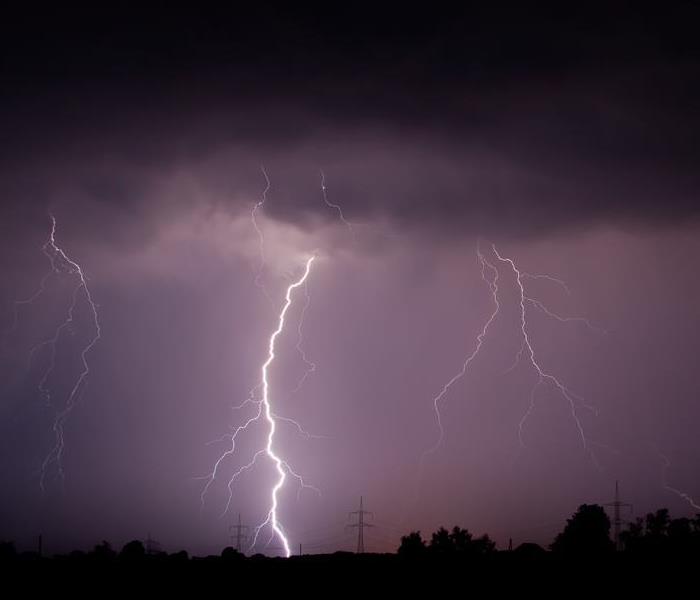 “In the spring I have counted one hundred and thirty-six kinds of weather inside of four and twenty hours.”
- Mark Twain
“In the spring I have counted one hundred and thirty-six kinds of weather inside of four and twenty hours.”
- Mark Twain
Spring storms can be unpredictable. In the spring there are days in which we are closer to summer and other days where it snows! The changing weather during the spring can cause potential hazards that can be hard to predict/plan for since the weather can change rapidly, leading to the experience of many seasons in the same day! Mark Twain once said, “In the spring I have counted one hundred and thirty-six kinds of weather inside of four and twenty hours.”
Thunderstorms pose the most serious weather related threat during the spring. Thunderstorms develop when warm moist air collides with cool, dry air. Some of the dangers associated with severe thunderstorms include lightning, tornadoes, and flooding. Although the weather in the spring can change so quickly there are something you can do in order to prepare. Having a first aid kit and an emergency evacuation/shelter plan as well as keeping a 3-5 day supply of water and non perishable food are all measures that can be taken to prepare for the potential of severe weather in the spring.
If your home or business experiences storm damage this spring, we are Here to help! Our Disaster Recovery Team is ready 24 hours a day, 365 days a year to respond to any disasters that may strike in any season.
Billion Dollar Disasters.
12/5/2019 (Permalink)
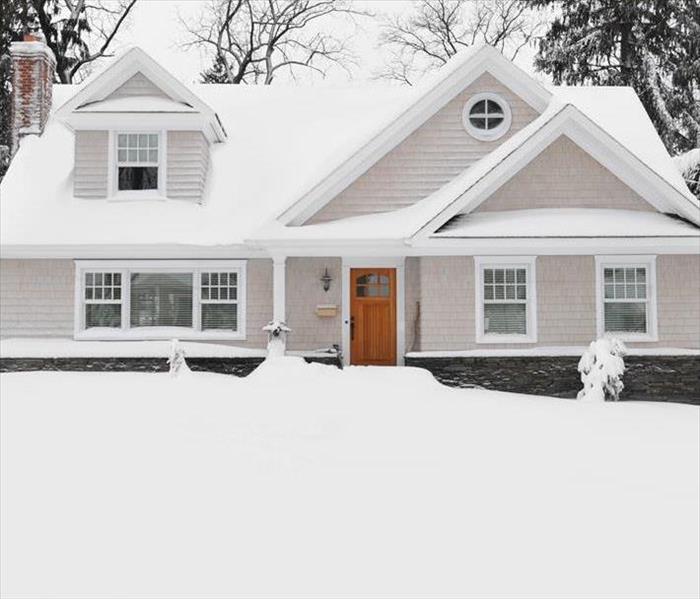 Don't let a winter storm cost you!
Don't let a winter storm cost you!
Since the year 1980 ten winter storms have caused over $2 billion of damage in the United States. Winter storms have the potential to produce strong winds, drop feet of snow on homes and businesses and the weight of ice from freezing rain can cause damage to power lines and trees. In addition the damage caused from the storm itself there is the aftermath of when all of the snow melts; a quick increase in temperate or heavy rain can set the stage for catastrophic flooding. For us here on the east coast we have face another winter storm hazard in the form of coastal flooding. Strong winds in combination with the high tide can overcome the coastline causing beach erosion and major damage to homes and businesses.
With winter weather approaching and the chance for severe winter storms increasing it is important to be prepared.
Keeping gutters clear of leaves and debris will allow water to move more freely and will help with drainage from your roof when snow begins to melt.
Keep your pipes warm to avoid them freezing and bursting. Open kitchen and bathroom cabinets to allow warm air to circulate around the pipes. If you have a cold basement/crawlspace, or attic with pipes make sure to wrap those pipes in insulation to help keep them from freezing. Drip your faucets to keep the water flowing, even a small trickle of water can prevent the pipes from freezing.
Check your roof prior to the storm and repair any damages that are apparent. If a large amount of heavy snow accumulates on your roof it can cause it to collapse. Use a roof rake to remove the snow from your roof to prevent collapsing from the weight and also to prevent ice-dam damage.
When snow has accumulated on your roof, it is important to keep your attic space cold. This prevents the development of an ice dam; The snow from melting and then refreezing near the edges as icicles which can cause roof leaks that leads to water coming into your home and causing damage water damage on walls and ceilings.
This winter if you suffer from any storm damage, SERVPRO Chesapeake South is Here to Help. With trained franchise professionals on call 24 hours a day, 365 days a year we are ready to make your storm damage “Like it never even happened.”
Ahead of the Storm
9/5/2019 (Permalink)
 SERVPRO of Chesapeake North will help clean up the storm damage in Chesapeake.
SERVPRO of Chesapeake North will help clean up the storm damage in Chesapeake.
Hurricane Prep Guide
Getting prepared for a hurricane in Hampton Roads is not only about buying lots of water or filling up the gas tank. There are steps needed to help protect you and your family if your home is threatened by a hurricane.
Stock Emergency Supplies
- Water & Food at least a 3-day supply for you and your pet
- Tools like flashlights, extra batteries, a wrench, plastic sheeting & duct tape, trash bags
- Medical Hygiene and Cleaning Supplies like a first-aid kit, necessary medications, glasses, contact lenses, moist towelettes, toothpaste, and personal hygiene products
- Personal Items, like sleeping bag for each person and change of clothing
- Activities like books, games, playing cards, paper, pencils and pens
- Radio for NOAA weather radio with tone alert and extra batteries
- Other Items like a whistle to signal for help
Prepare and Protect Your Property
- Do a Home Inventory with contents of closets, drawers and cabinets? Store your home inventory lists, photographs and video tapes in a waterproof place off the premises. Keep receipts of high valued items, which may separate insurance coverage. Always update your home inventory after making large purchases.
Review Your Insurance Policies
- Is everything up to date? If you’ve done any major renovation or made a major purchase, make sure your insurance agent is aware to help determine if your current limits are enough to cover the value.
- Coverage for additional living expenses in case you can’t live in your home until it has been restored from damages.
- What about flood damage? Do you have coverage?
- Do you have comprehensive coverage on your car insurance policy? What happens if a tree falls on it or water, wind or flying debris damages your car?
Plan Your Evacuation
- Become familiar with alternate routes in case travel becomes treacherous or traffic congested
- If you don’t have a car, plan on how you will leave if you need to evacuate; make plans with family or friends or your local government or aid agencies
- Plan what you will do with your pets, leave them with family, take them with you or to a kennel
- Keep a road map in your car in case you need another route on unfamiliar roads
- Prepare a bag or file with important papers, like your homeowner’s insurance policy, keep it with you.
If you have suffered water damage after a storm, SERVPRO of Chesapeake North is prepared to assist you after the storm to clean up the mess and help restore your home to its pre-storm condition. We are “Always Here to Help.” Call us at 757-465-9700.
SERVPRO® Emergency Preparedness Tips
6/21/2019 (Permalink)
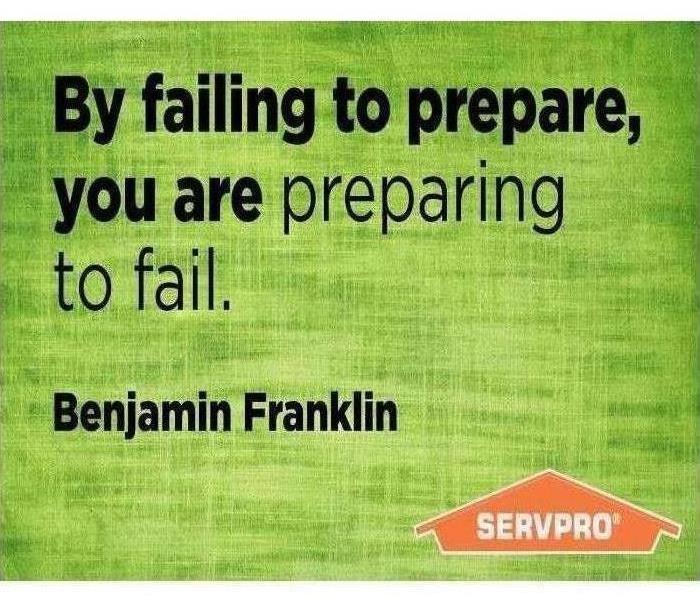 Storm Damage Cleanup by SERVPRO® of Chesapeake North 757-465-9700
Storm Damage Cleanup by SERVPRO® of Chesapeake North 757-465-9700
SERVPRO® of Chesapeake North Encourages Virginia Residents to be Storm Ready
A Few Steps to Prepare and Protect Your Family
It's the beginning of hurricane season on the Atlantic coast and SERVPRO® of Chesapeake North would like for everyone to remember the importance of disaster preparedness. The key to disaster preparedness is having an emergency plan in place before the disaster hits. Acting with a few simple steps can make the difference in protecting and keeping your family safe and protecting your property from weather related damage.
Build a basic emergency supply kit stocked with enough water and food for a minimum of three days for you and for each of your family members, pets included. Be mindful to include any necessary medications. Recommended emergency supply kit items include:
- Water (one gallon/per person/per day)
- Three-day supply of non-perishable foods
- Manual can opener
- Battery or solar powered radio, preferably a NOAA weather radio
- Flashlight with extra batteries
- Whistle (to signal for help)
- Dust masks or bandanas
- Local map
- Important documents, such as insurance policies, bank account information, passwords, and identifications
- Matches (in a waterproof container) and/or lighter
Make a Family Emergency Plan. A Disaster may not strike when you and your family are together at home. Plan now for a meeting place and how you will contact each other. Visit ready.gov to access a Family Emergency Plan template to help with your planning.
Stay Informed. Know your flood zone for your property and your neighborhood and know the evacuation route should evacuation become necessary. Listen to your local news and authorities for direction.
Prepare your property. You may need to prepare your home for the impact of a storm or hurricane. Covering all your windows in your home will help to protect it. Permanent storm shutters offer the best protection for windows; however, the second-best option is to board up the windows with plywood. Tape will not prevent your windows from breaking. Trim your trees and bushes that are around your home and clear any debris from rain spouts and gutters. Secure outdoor furniture, trash receptacles, decorations and anything else not secured that could become projectile.
Establish a SERVPRO® Emergency READY Profile for Your Business. SERVPRO® developed the SERVPRO® Emergency READY Program to help business owners create an Emergency READY Profile® (ERP) for their facility, at no charge. The business owner works with SERVPRO® of Chesapeake North to gather and document information that will become critical if a disaster strike. Once the ERP is created, business owners have access to their own information 24/7 online and by using SERVPRO’s free smartphone app. Contact us at 757-465-9700 to get set up.
Power Outage Kit
2/12/2019 (Permalink)
 SERVPRO of Chesapeake North
757-523-9700
SERVPRO of Chesapeake North
757-523-9700
Power Outage Kit
The American Red Cross suggests that every household have an emergency preparedness kit for your home and for your car. Unfortunately, only a little more than a half of the homes in the U.S. have an emergency kit.
Your power outage kit can start with a duffle bag or a backpack. Depending on the situation, the kit can be a 3-day supply for an evacuation or a 2-week supply for home. The kit should include at least a gallon of water per person, per day, canned food, a can opener, flashlights, batteries, a first aid kit, personal hygiene items, a multi-purpose tool, and medications, and copies of personal documents such as proof of address, deed/lease, passports, birth certificates, and insurance policies. A printed list of emergency phone numbers and of family and friends. The needs of all family members including your pets should be considered when building your emergency kit. Learn more about what you need in a survival kit.
We will continually bring you more tips and information on how to best be prepared in case of disaster. Should you find yourself with a water damage disaster from a broken pipe or from a damaged water tank in your home or business, call the team that has been serving the Chesapeake area for over 20 years. Call SERVPRO of Chesapeake North 24/7, 365 to help you when emergency strikes. #SERVPROChesN #PowerOutageKit #AlwaysHereToHelp
Before Winter Arrives. . . Don’t Let Pipes Freeze
12/4/2018 (Permalink)
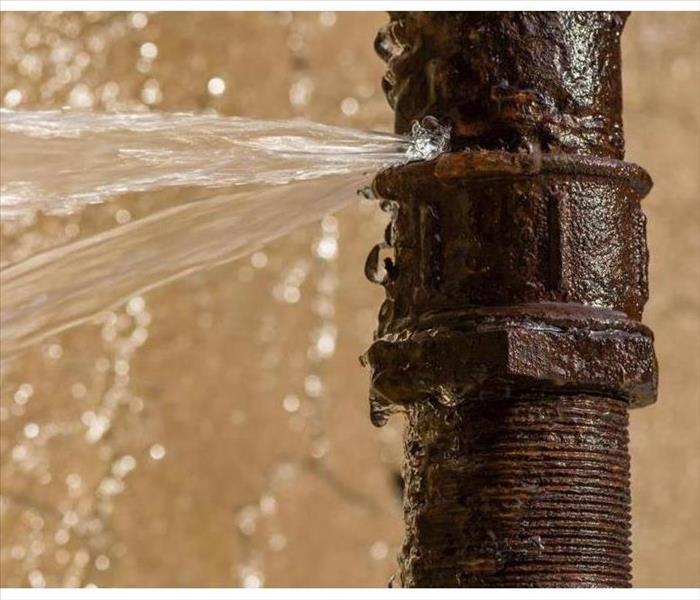 Water pipes burst in Chesapeake.
Water pipes burst in Chesapeake.
Before Winter Arrives. . . Don’t Let Pipes Freeze
A major home maintenance disaster is bad enough in itself, but when several disasters happen all at once, well that’s a nightmare. Especially when your water pipes freeze because not only do you have to call a plumber, but that crack in your pipe can spew up to 250 gallons of water a day, causing flood damage, serious structure damage, and the immediate potential for mold damage.
The causes of frozen pipes are quick and sudden drops in temperature, poor insulation, and thermostats that are set too low. Now is the time when the temps are warmer to prepare your home and here are a few preventive precaution steps.
- Insulate your pipes in your crawlspace and in your attic. Exposed pipes are vulnerable, and the more insulation, the better.
- Use approved and tested insulation products for use intended, either indoors or outdoors and make sure to follow the manufacturers’ instructions.
- Seal those leaks near or around the pipes. Electrical wiring outlets, dryer vents, and pipes can be caulked or insulated to keep out the cold air. The least little opening during severe cold weather can cause a pipe to freeze.
- Disconnect garden hoses before winter and if you can drain water from indoor pipes that lead to outside faucets and shut off the valve. This can help prevent that little bit of inside pipe from freezing.
If you have water or flood damage, call us at 757-465-9700, Your 24Hr. Emergency Service.
Hurricanes. . . Plan Ahead
9/10/2018 (Permalink)
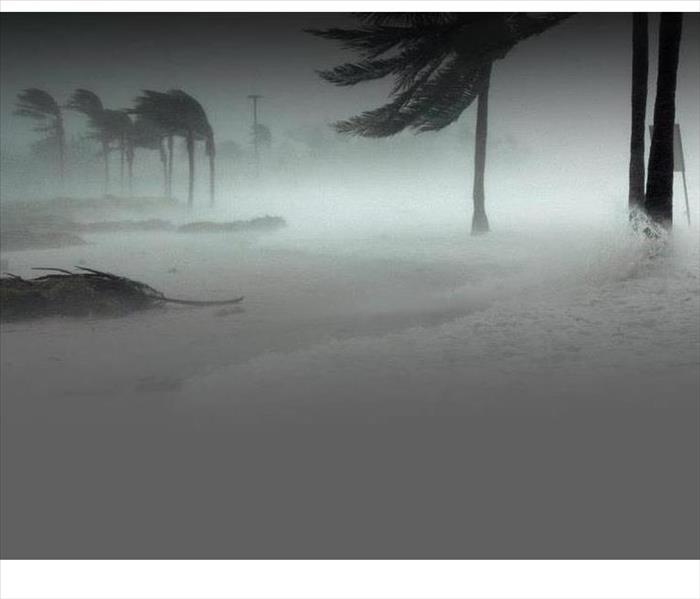 Hurricanes. . . Plan Ahead
FEMA News Photo
Hurricanes. . . Plan Ahead
FEMA News Photo
Hurricanes. . . Plan Ahead
Hurricanes are huge storm systems that form over warm ocean waters. These systems move towards land with threats of powerful winds, heavy rainfall, storm surges, coastal and inland flooding, rip currents, landslides and tornadoes. The Atlantic hurricane season runs from June 1 to November 30. Hurricanes are most active in September.
- Remember that if you are under a hurricane warning, you should find shelter sooner rather than later to protect yourself from high winds and flooding. You should evacuate if you are told to do so. If you must take refuge, you should do so in a storm shelter, or an interior room for high winds. Make sure you have a way to receive and listen for emergency information and alerts. Use a generator outdoors only and away from windows. #FloodSmart turn around, don’t drown! You shouldn’t walk, swim, or drive through flood waters.
Plan Ahead
When a hurricane is 36 hours from arriving
- Turn on the TV or radio to get the latest weather updates and emergency instructions.
- Restock your emergency preparedness kit, and include food & water enough for at least three days, medications, a flashlight, batteries, cash, and first aid supplies.
- Prepare to use your family communication plan if you lose power. For example you can call, text, or email or use social media. Remember that during disasters, sending text messages is usually more reliable and faster than making a phone call.
- Know and review your evacuation route and shelter locations with your family as you may have to leave quickly.
- Keep your car in good working condition with a full tank of gas, emergency supplies and extra clothing.
Next: Plan Ahead. . . When a Hurricane is 18 -36 hours From Arriving
Prepare Now for 2018 Hurricane Season
6/4/2018 (Permalink)
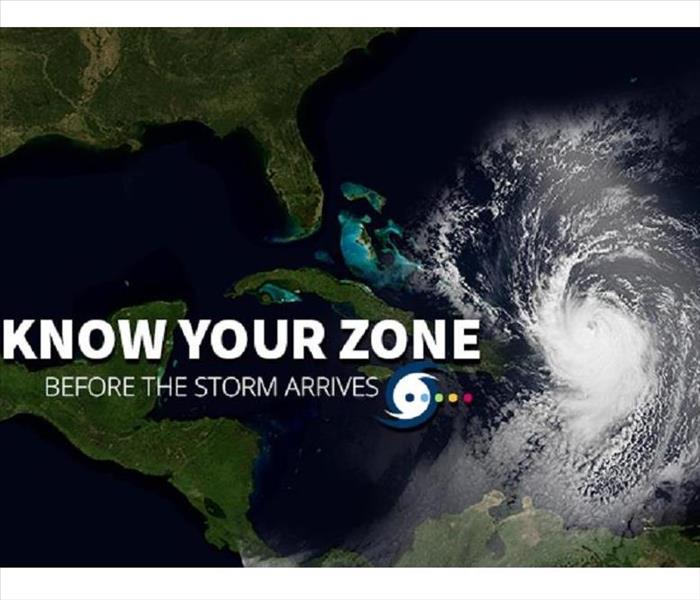 Find Your Zone
Find Your Zone
In 2017, many regions suffered through nightmarish scenarios from multiple hurricanes.
Virginia, however, has not experienced a direct hit from a major hurricane in generations. The Virginia Department of Emergency Management (VDEM) says not if, but when, and is encouraging all Virginians to start preparing today for the 2018 hurricane season which officially began on June 1st.
"Hurricanes cause high winds, tornadoes and landslides, but their deadliest hazard is flooding. Tropical storms and depressions can be just as dangerous."
Coastal Virginians, you need to know your hurricane evacuation zone for both your home and workplace. Evacuation zones A through D are in place across coastal Virginia. Residents will be directed to evacuate depending on the tides, the storms intensity, it's path and other factors.
Winter Storm Watch. . . Be Prepared in Chesapeake
1/2/2018 (Permalink)
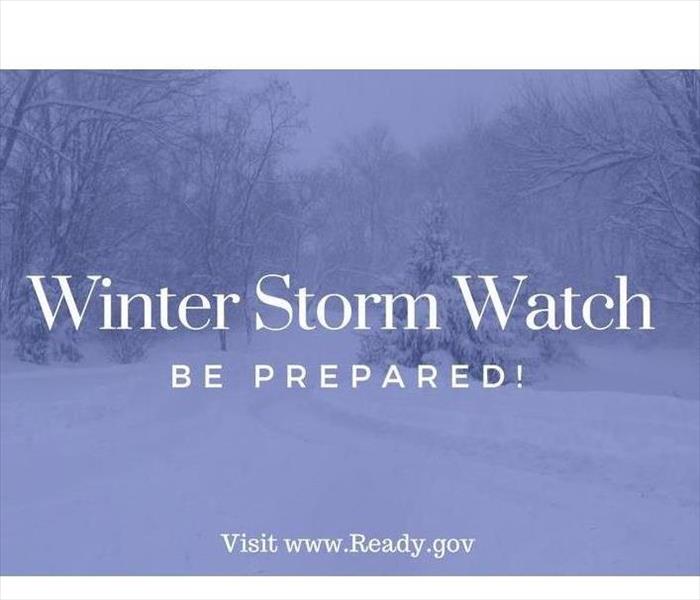 SERVPRO of Chesapeake North 757-465-9700.
SERVPRO of Chesapeake North 757-465-9700.
Winter Storm Watch. . . Be Prepared in Chesapeake
A winter storm watch happens when there is a combination of a tremendous amount of precipitation and extremely cold temperatures. A winter storm can cause sleet or snow or even falling ice. The snow can be moderate and last a few hours or the snowfall can turn into a blizzard lasting for several days.
Winter storms can cause power outages and close roads and walkways, or make them impassable and very dangerous.
Safety precautions are necessary to take in order to be safe and protected from the disaster of the winter storm. More info to be found about Snowstorms & Extreme Cold
SERVPRO of Chesapeake North has been taking care of storm damage since the 60's. We are always here to help.
Winter Weather
12/18/2017 (Permalink)
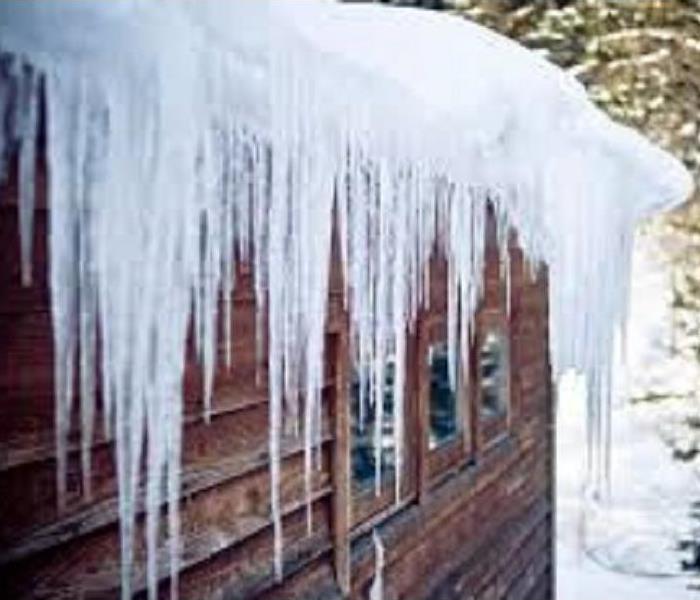 SERVPRO of Chesapeake North, 757-465-9700
SERVPRO of Chesapeake North, 757-465-9700
Ice dams can be a major problem during the winter season. Cold weather, snow and ice storms can cause severe damage to your home or your office.
Ice dams form when the heated air melts the roof snow downward and the melted water runs into ice that is still frozen causing the water to dam up. When this water is trapped, it can not flow or run into the gutter system and can backflow under the roof shingles and into the interior structure of your house or business.
Ice Dam damage:
- Water can seep into your home or building’s walls, ceilings, insulation and other interior areas.
- Ice dams can lift roof shingles causing water to leak inside your home.
- Pressure and weight from the dams can pull off your gutters and lead to structural damage.
Our friends at Nationwide blog about Preventing Ice Dam Damage to Your Roof and Home.
If this disaster strikes, you need to take immediate action to prevent additional damage to your property. SERVPRO of Chesapeake Northr fanchise professionals have the winter storm experience and expertise, and the resources to remediate damage caused by winter weather.
Winter Weather Alerts
12/11/2017 (Permalink)
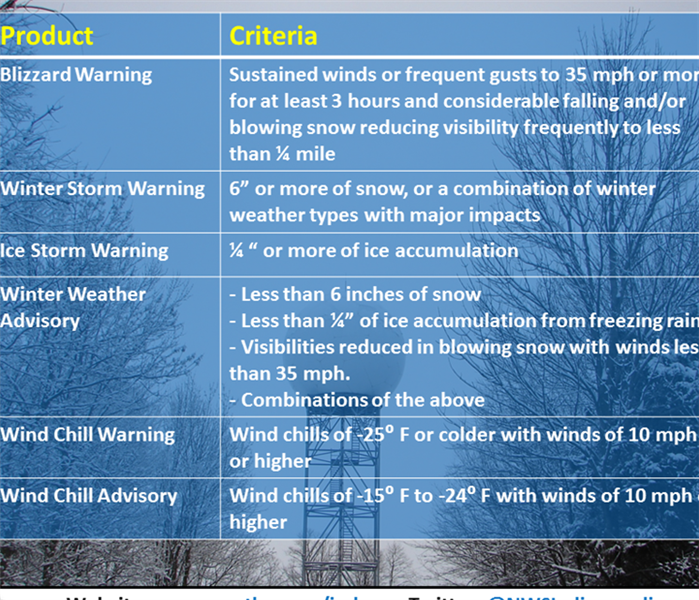 SERVPRO of Chesapeake North, 757-465-9700.
SERVPRO of Chesapeake North, 757-465-9700.
SERVPRO of Chesapeake North wants to help you to be prepared for the upcoming winter weather. The National Weather Service will issue advisories and warnings. It is important that you understand these and know how to prepare for winter and to be Winter Safe.
- Blizzard Warning- Winds or gusts to 35 mph or more for at least 3 hours and lots of falling or blowing snow reducing your visibility to less than ¼ mile.
- Winter Storm Warning- 6” or more of snow, or a combination of winter weather types with major impacts.
- Ice Storm Warning- ¼” or more of ice accumulation.
- Winter Weather Advisory- Less than 6” of snow, Less than ¼” of ice accumulation from freezing rain, Visibilities reduced in blowing snow with winds less than 35 mph, Combinations of these.
- Wind Chill Warning- Wind chills of -25°F or colder with winds of 10 mph or higher.
- Wind Chill Advisory- Wind chills of -15°F to -24° with winds of 10 mph or higher.
SERVPRO of Chesapeake North has been serving the community since 1967. We specialize in storm damage restoration. Our crews are highly trained, and we use specialized equipment to restore your property to its pre-storm condition.
Power Outage Gadget Picks in Chesapeake
9/13/2017 (Permalink)
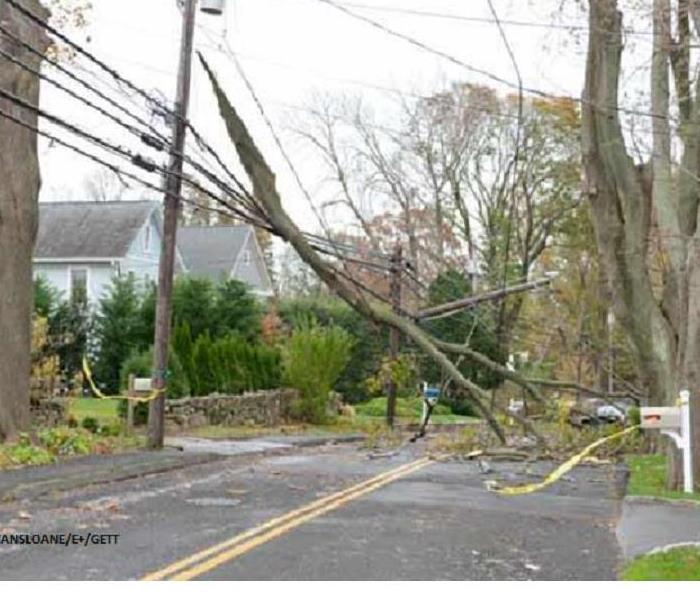 Power lines taken out by a tree.
Power lines taken out by a tree.
More than 60% of power outages are a result of stormy weather and your best defense against the dark is to have on hand power outage gadgets at home or the office.
Our friends and experts #ThisOldHouse have compiled a list of handy power outage essentials that will help you and your family or employees get through the night without leaving you feeling so . . . powerless.
Essentials such as an All-Weather Radio that bests your smartphone using three different power sources, a Cell Phone Charger that juices up with a manual crank or hold a charge for a full year, a Waterproof lantern made to brave the worst of camping conditions, a tripod flashlight with gripping legs and magnetic feet. and last but not least, a plug-in lamp that turns on automatically when the power goes out, so you can see where you are walking.
When Storms or Floods Hit Chesapeake, SERVPRO is ready!
6/27/2017 (Permalink)
SERVPRO of Chesapeake specializes in storm and flood damage restoration. Our crews are highly trained and we use specialized equipment to restore your property to its pre-storm condition.
Faster Response
Since we are locally owned and operated, we are able to respond quicker with the right resources, which is extremely important. A fast response lessens the damage, limits further damage, and reduces the restoration cost.
Resources to Handle Floods and Storms
When storms hit Chesapeake, we can scale our resources to handle a large storm or flooding disaster. We can access equipment and personnel from a network of 1,650 Franchises across the country and elite Disaster Recovery Teams. Disaster Recovery Teams that are strategically located throughout the United States.
Have Storm or Flood Damage? Call Us Today [757-465-9700]
When Storms or Floods hit Chesapeake SERVPRO is ready!
8/31/2016 (Permalink)
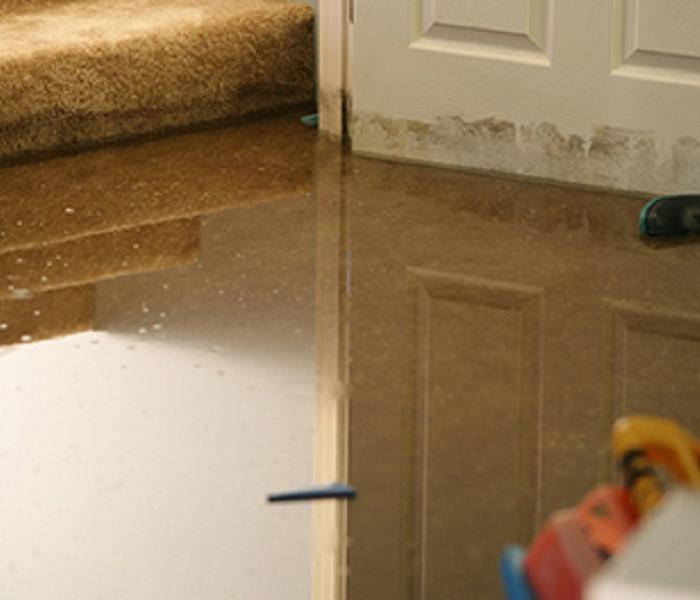 Our highly trained crews are ready to respond 24/7 to storm or flood damage in Chesapeake.
Our highly trained crews are ready to respond 24/7 to storm or flood damage in Chesapeake.
SERVPRO of Chesapeake specializes in storm and flood damage restoration. Our crews are highly trained and we use specialized equipment to restore your property to its pre-storm condition.
Faster Response
Since we are locally owned and operated, we are able to respond quicker with the right resources, which is extremely important. A fast response lessens the damage, limits further damage, and reduces the restoration cost.
Resources to Handle Floods and Storms
When storms hit Chesapeake, we can scale our resources to handle a large storm or flooding disaster. We can access equipment and personnel from a network of 1,650 Franchises across the country and elite Disaster Recovery Teams that are strategically located throughout the United States.
Have Storm or Flood Damage? Call Us Today (757)465-9700.
The Differences Between Storms
7/27/2016 (Permalink)
 Know your storm terminology and stay safe this season.
Know your storm terminology and stay safe this season.
With hurricane season in full swing, there are a few terms that are becoming frequent on our morning weather forecasts: Tropical Depression, Tropical Storm, and Hurricane. What is the difference, and how should we react to each?
Tropical Depression
A tropical depression forms when a low pressure area is accompanied by thunderstorms that produce a circular wind flow with maximum sustained winds below 39 mph. Most tropical depressions have maximum sustained winds between 25 and 35 mph.
In the U.S., the National Hurricane Center (NHC) is responsible for issuing advisories upgrading or downgrading tropical activity.
Reconnaissance aircraft missions are sent by the NHC flying into tropical storms to gather data, like wind speeds, to aid in making these classification changes. Surface data from islands, buoys and vessels can also be used to make changes.
These systems can turn into Tropical Storms, and ultimately hurricanes or they can begin to diminish before even making landfall.
Tropical Storm
An upgrade into a tropical storm occurs when cyclonic circulation becomes more organized and maximum sustained winds gust consistently at or above 39 mph, and no higher than 73 mph. Tropical storm status is when the naming of the storm takes place.
These systems can become a problematic when they make land fall with increases in flash flooding for coastal areas.
Hurricane Classification
A tropical storm is then upgraded into Category 1 hurricane status as maximum sustained winds increase to between 74 mph and 95 mph.
The Saffir-Simpson Hurricane Scale is used to rate hurricane intensity in the Atlantic Basin. A 1-5 rating system is used, with Category 1 being a less intense storm and Category 5 very intense.
Only 3 Category 5 hurricanes have made landfall in the U.S. in the 20th and 21st century. The three Category 5 storms to hit the USA were the 1935 Florida Keys "Labor Day" hurricane, Hurricane Camille, which hit Mississippi in 1969, and Hurricane Andrew, which hit Dade County, Fla., on Aug. 24, 1992.
The most important thing to remember during hurricane season is to be prepared! Preparing now will save you from long lines at the store, and afford you effective evacuation routes. When it comes time for clean up after the storm, SERVPRO® of Chesapeake will be here to make it “Like it never even happened.”
Hurricane Preparedness in Chesapeake
7/18/2016 (Permalink)
With hurricane season upon us, it is important to be prepared. Even with advanced warnings, hurricanes can be deadly and it pays to have a plan in place. Below are some tips to get your family and home Hurricane Ready.
Supply Kits
Create a supply kit. These can be stored in large plastic totes or in a large backpack for grab and go emergencies. Keep non-perishable foods, water, flashlights, batteries, an emergency weather radio, list of emergency contact numbers, a map, and any medications that would be needed for your family and pets. For kits that can be taken on the road, include small activity books to have on hand as well.
Written Emergency Plan
Mark out locations that you and your family can evacuate to. Plan for additional areas further inland in case of a larger storm system. Create an Emergency Preparedness Plan for your business. This can be done with SERVPRO® of Chesapeake.
The most important thing to remember during hurricane season is to be prepared! Preparing now will save you from long lines at the store, and afford you effective evacuation routes. When it comes time for clean up after the storm, SERVPRO® of Chesapeake will be here to make it “Like it never even happened.”
What is Heat Lightning?
7/1/2016 (Permalink)
With summer comes summer storms and who hasn’t seen heat lightning flashing along the horizon on a muggy evening. But what is heat lighting, and is it dangerous?
What is Heat Lightning?
Sometimes during a storm, you can see lightning strike, but cannot hear the thunder as there is large distance between you and the storm. This is known as heat lightning. As there is no audible sound of thunder, the lightning is just seen as a flash of light.
As the lightning takes place far away, the sound waves get dispersed while traveling and do not reach the observer. Heat lightning is nothing but ordinary lightning, minus the sound of thunder. It is a term used to describe flashes of light that are seen near the horizon. As light flashes can travel to a larger distance than sound waves, only the flashes of light are seen, but the thunder is not heard.
Facts about Heat Lightning
- It occurs in summers and especially on hot summer nights. Hence, it is named so.
- It is not followed by thunder and rainfall like ordinary lightning. The thunder and rainfall actually take place at a distance, and so are not observed.
- The Earth's curvature, airborne elements like snow or dust, etc., can muffle the sound of the thunder.
- Heat lightning can be seen all over the world. It is especially common in the mountainous regions.
- It is usually an indication of an approaching storm.
- Many lightning casualties occur in the summer months. But, chances of being struck by lightning can be prevented if you follow safety rules.
- Just because you cannot hear the thunder, does not mean you are not at a risk of getting struck by the lightning. Remember that light travels faster than sound.
Is Heat Lightning Dangerous?
Heat lightning is equally as dangerous as ordinary lightning. Many people enjoy watching the brilliant orange flashes of light near the horizon. But it is advised to immediately seek shelter indoors. As mentioned above, it is an indication of an invading storm, and people may not realize how close the storm is and may be under risk of getting struck by the lightning.
Lightning Safety Measures
Remember, when you see lightning, always stay indoors. If you are outdoors, it is best to stay in your car or seek shelter in nearby buildings. Avoid standing under a tree or seeking shelter in very high buildings. If you are on a hilltop, try to seek shelter as you are at a higher risk of getting struck with lightning. One should also stay away from electrical poles or telephone lines. It is even advised not to use plug-in electrical equipment for safety reasons.
If your home is damaged by storms this summer, call SERVPRO® of Chesapeake at (757)465-9700





 24/7 Emergency Service
24/7 Emergency Service
